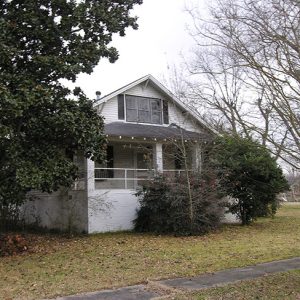calsfoundation@cals.org
Dickinson-Moore House
Constructed circa 1915, the Dickinson-Moore House in Arkansas City (Desha County) has experienced the ebb and flow of the city’s history, as well as its floodwaters. Like many buildings in Arkansas City, it was built upon a tall foundation to protect it from the high water that frequently inundated the area. This practical adaptation makes the Dickinson-Moore House a unique example of Craftsman architecture in Arkansas City.
It is believed that a member of the Dickinson family had the house built. The Dickinson family patriarch in the town was planter and attorney Colonel J. W. Dickinson, of whom the Goodspeed history of the area speaks rather glowingly: “No name is entitled to a more enviable place in the history of Desha County than the one that heads this sketch.” Born in Tennessee, Dickinson moved from Memphis to Arkansas City in 1874. There, he studied law and, in 1879, was elected to the Arkansas legislature. The Dickinsons occupied the house for only a decade or so, selling it to Arthur Preston Price and his wife in the mid-1920s. The Prices lived there with their daughter Dorothy Elizabeth Price.
Dorothy Price and her parents were living in the Dickinson-Moore House when the Flood of 1927 ravaged the area. Their family home, she recalls, was almost completely under water: “My brother took me out to our house in a motorboat. I could just see the tip of the house.” The floodwater reached eight feet deep in the rooms. Price attended college at Hendrix College in Conway (Faulkner County). In 1930, she moved back to her hometown and soon began work at Sheriff Howard L. Clayton’s office.
Robert Moore was born in 1908, the son of state Senator I. N. Moore Sr. After graduating as valedictorian of Dumas High School, he attended what is now Ouachita Baptist University. Moore soon returned to Desha County, where he worked under Sheriff Howard L. Clayton and met Dorothy Price, whom he later married. The couple moved into the Dickinson-Moore House with Dorothy’s parents, and less than a year later, the Moores gave birth to a daughter. With this new addition to the family, the house became too crowded for the Price parents, who soon moved out. The Moores resided in the Dickinson-Moore House for the remainder of their lives. Robert Moore quickly became a prominent citizen of Arkansas City, serving as deputy treasurer before taking office as circuit and chancery clerk in 1945. In 1948, he ran for the office for which he is best known—Desha County sheriff. Moore won and took office on January 1, 1949.
Moore’s service as Desha County sheriff would define his career. He was elected to thirteen consecutive terms, during which time he became involved in law enforcement organizations on the state and national level. He served as president of the Arkansas Peace Officers Association, the Arkansas Sheriffs Association, and the National Sheriffs Association, and was instrumental in the formation of the Arkansas Law Training Academy.
After Moore died on March 12, 1973, from injuries received in a two-car accident on Highway 65, just south of Pine Bluff (Jefferson County) on March 10, Governor Dale Bumpers appointed his widow, Dorothy, to finish out his thirteenth term. She went on to work as a receptionist for Governor Bill Clinton before returning to Arkansas City, where she lived in the Dickinson-Moore House until her death in 2008, at the age of ninety-seven.
This property was listed on the National Register of Historic Places on February 1, 2011.
For additional information:
“Dickinson-Moore House.” National Register of Historic Places nomination form. On file at Arkansas Historic Preservation Program, Little Rock, Arkansas. Online at http://www.arkansaspreservation.com/National-Register-Listings/PDF/DE0290.nr.pdf (accessed November 9, 2021).
Moore, Dorothy P., Dorothy Lee Moore Paige, and Robert S. Moore Jr. “Robert Smith Moore Sr.” Programs of the Desha County Historical Society 20 (1996): 34–49.
Ben Harvey
Arkansas Historic Preservation Program
 Early Twentieth Century, 1901 through 1940
Early Twentieth Century, 1901 through 1940 Dickinson-Moore House
Dickinson-Moore House 




Comments
No comments on this entry yet.